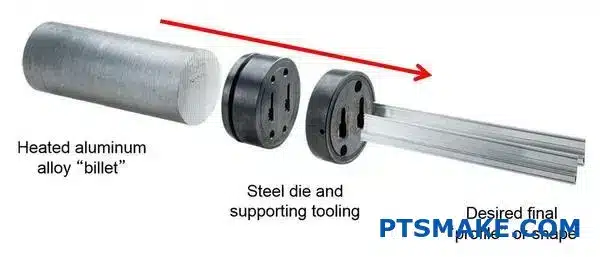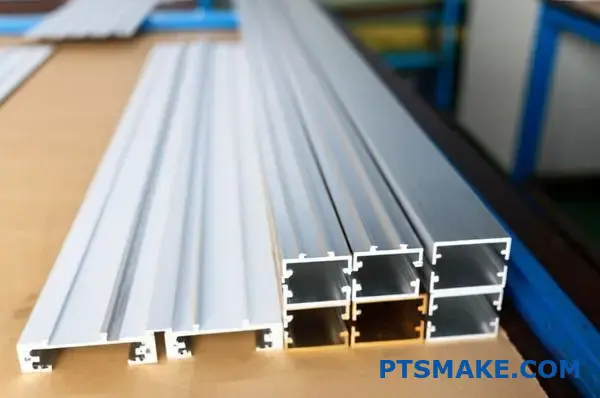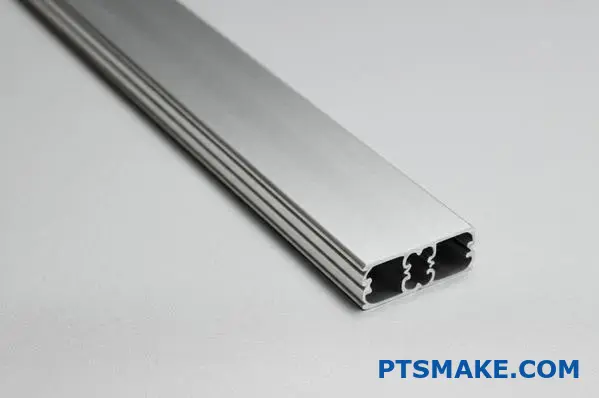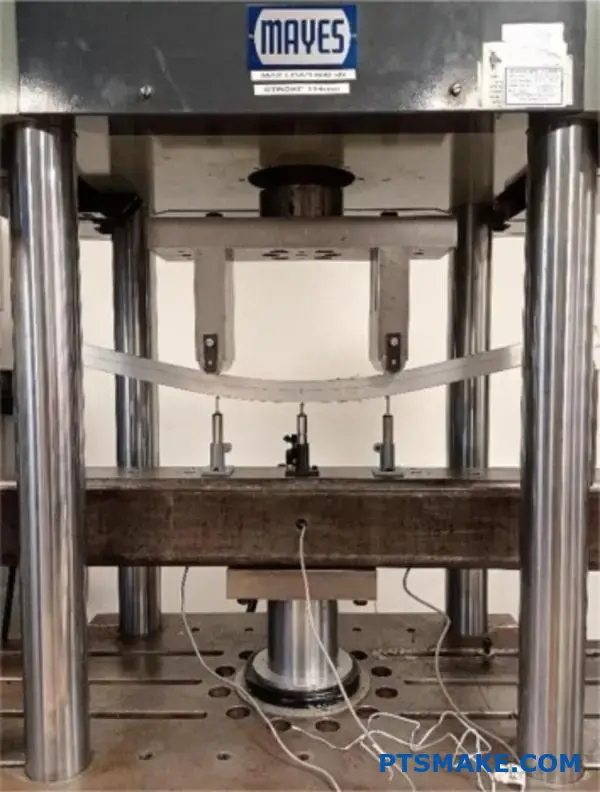Are you struggling with precision issues when machining nylon parts? Many engineers face challenges with dimensional accuracy when working with this material. The unpredictable expansion and contraction of nylon can lead to rejected parts and production delays.
Nylon can generally achieve tolerances of ±0.005 inches (0.127mm) for most dimensions when properly machined. With specialized techniques and controlled environments, tighter tolerances of ±0.002 inches (0.0508mm) are possible for critical features.
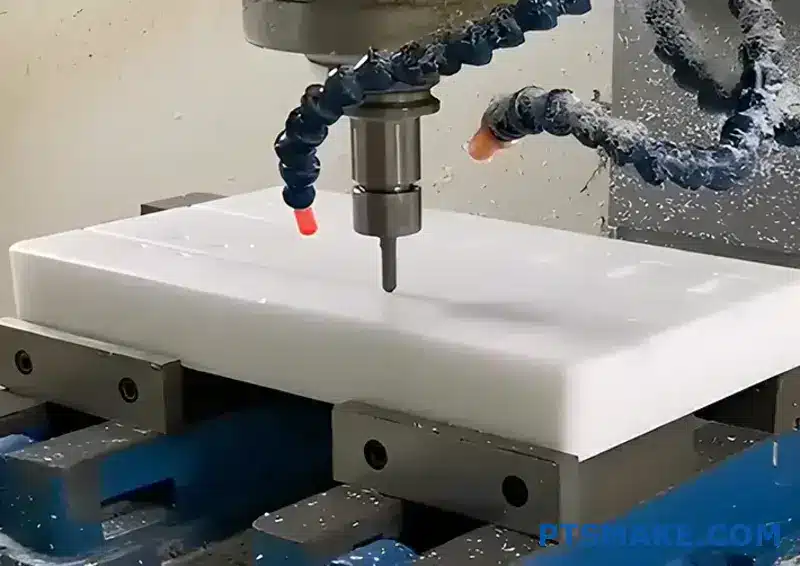
Working with nylon requires understanding its unique properties. As a hygroscopic material, nylon absorbs moisture from the air, which affects its dimensions. Temperature changes during machining can also cause expansion. I’ve developed specific strategies at PTSMAKE to overcome these challenges while maintaining tight tolerances. Let me share what works for consistent, high-precision nylon parts.
Is Nylon Good for Machining?
Have you ever struggled with selecting the right plastic for your project? Perhaps you’ve watched a part fail during machining or experienced poor performance in field applications? Choosing the wrong material can waste both time and resources.
Yes, nylon is excellent for machining due to its high strength-to-weight ratio, good wear resistance, and machinability. It produces smooth surfaces with proper tooling and parameters, though its thermal sensitivity requires careful machining practices to prevent melting or deformation.
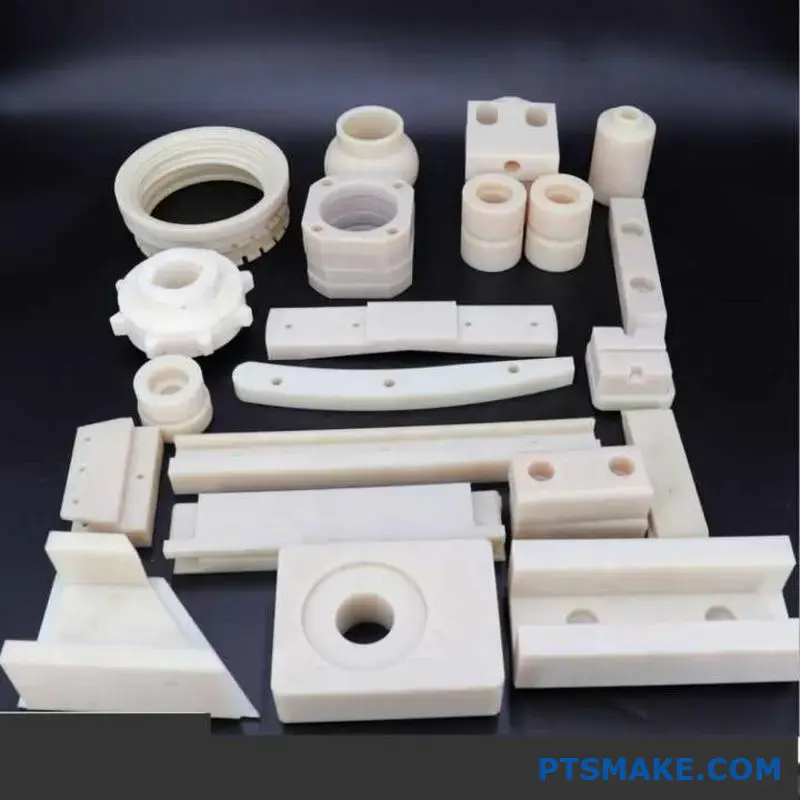
Understanding Nylon as an Engineering Material
Nylon belongs to the polyamide family of thermoplastics and has become a staple in precision manufacturing. Its unique combination of mechanical properties makes it particularly attractive for machined components across various industries. During my time at PTSMAKE, I’ve worked with many different grades of nylon, each offering specific advantages.
The most common machining grades include:
- Nylon 6
- Nylon 6/6
- Cast nylon (MC nylon)
- Glass-filled nylon
- Oil-filled nylon
Each type has specific characteristics that make them suitable for different applications. Cast nylon (MC nylon), for example, offers improved dimensional stability and machinability compared to extruded varieties.
Key Properties That Make Nylon Suitable for Machining
Nylon’s popularity in machining stems from several beneficial properties:
Mechanical Strength and Durability
With a tensile strength ranging from 70-85 MPa (depending on the grade), nylon offers excellent mechanical performance. Its impact resistance exceeds that of many other engineering plastics, making it ideal for parts subject to shock or vibration.
Wear Resistance
Nylon exhibits outstanding wear resistance and low friction coefficients. This makes it perfect for bearings, gears, and other components with moving interfaces. The self-lubricating properties of certain nylon grades further enhance this advantage.
Chemical Resistance
Unlike metals that corrode, nylon resists many chemicals, oils, and fuels. This property makes it valuable in automotive, chemical processing, and food processing equipment where exposure to harsh substances is common.
Machining Characteristics of Nylon
When it comes to actual machining operations, nylon presents both advantages and challenges:
Cutting Performance
Nylon machines relatively easily with sharp tooling. It produces clean cuts with minimal burr formation when proper speeds and feeds are maintained. However, its viscoelastic behavior1 requires attention to prevent material deformation during machining.
Heat Sensitivity
One of the primary challenges when machining nylon is heat management. With a relatively low melting point (around 220°C for nylon 6/6), excessive heat from machining operations can cause:
- Material melting
- Dimensional distortion
- Tool loading (material sticking to cutting edges)
In our CNC operations at PTSMAKE, we typically use coolant or compressed air to manage heat buildup when machining nylon parts.
Dimensional Stability Considerations
Nylon absorbs moisture from the atmosphere, which can affect dimensions. For precision parts, we often:
- Pre-condition material before machining
- Allow for dimensional changes in the design
- Use stabilized grades with reduced moisture absorption
The following table compares nylon’s machinability characteristics with other common engineering plastics:
| Property | Nylon | Acetal (POM) | PEEK | UHMW-PE |
|---|---|---|---|---|
| Ease of Machining | Good | Excellent | Good | Fair |
| Heat Sensitivity | Moderate | Low | High | Low |
| Dimensional Stability | Fair | Excellent | Excellent | Poor |
| Surface Finish | Good | Excellent | Good | Fair |
| Tool Wear | Low | Low | Moderate | Moderate |
Best Practices for Machining Nylon
Based on my experience with hundreds of nylon machining projects, I recommend these practices:
Tooling Selection
- Use sharp, polished cutting tools
- Positive rake angles work best (10-20 degrees)
- High-speed steel (HSS) tools work well, but carbide provides longer tool life for production runs
Cutting Parameters
- Higher cutting speeds than metals (500-1000 SFM)
- Moderate feed rates to prevent heat buildup
- Light depth of cuts, especially for finishing operations
Workholding Methods
Nylon’s flexibility can make secure workholding challenging. We typically use:
- Multiple contact points to distribute clamping forces
- Custom fixtures for complex parts
- Vacuum tables for thin sections
Cooling Approaches
- Flood coolant for most operations
- Air cooling for simple cuts
- Mist cooling systems for complex geometries
By following these practices, we consistently achieve tolerances of ±0.05mm on nylon components, which satisfies most precision engineering requirements.
How Thin Can You Machine Nylon?
Have you ever struggled with machining nylon down to extremely thin dimensions? The frustration of parts warping, tools chattering, or experiencing unexpected material failure can derail your entire project. It’s a common challenge that requires specific expertise to overcome.
Nylon can typically be machined to a minimum thickness of 0.02 inches (0.5mm) in most commercial applications. However, with specialized equipment and proper techniques, skilled machinists can achieve thicknesses as low as 0.01 inches (0.25mm) while maintaining structural integrity.
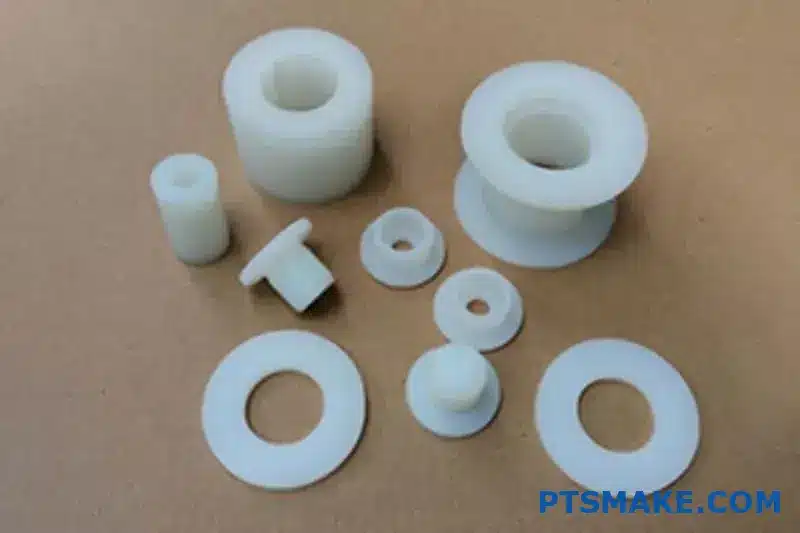
Factors Affecting Minimum Thickness in Nylon Machining
When approaching thin-wall nylon machining, several key factors determine how thin you can practically go. After working with countless nylon components at PTSMAKE, I’ve identified the critical elements that influence minimum achievable thickness.
Material Grade Selection
Not all nylon grades behave the same when machined to thin dimensions. The specific type of nylon significantly impacts how thin you can reliably machine it:
| Nylon Type | Minimum Practical Thickness | Best Applications |
|---|---|---|
| Nylon 6 | 0.03" (0.76mm) | General mechanical components |
| Nylon 6/6 | 0.025" (0.64mm) | Higher strength requirements |
| Nylon 6/12 | 0.02" (0.5mm) | Moisture-sensitive applications |
| Cast Nylon | 0.015" (0.38mm) | Precision components |
| Glass-filled Nylon | 0.04" (1mm) | High-strength structural parts |
Glass-filled nylons, while offering excellent strength properties, typically can’t be machined as thin as unfilled varieties due to the reinforcing fibers that create more complex machining conditions and increase the risk of delamination2.
Machining Strategy for Ultra-Thin Walls
When attempting to create nylon parts with walls thinner than 0.03 inches, the machining strategy becomes crucial:
- Step-down Approach: Rather than removing all material at once, gradually reduce thickness in multiple passes.
- Appropriate Tooling: Use sharp, properly sized cutting tools specifically designed for plastics.
- Speed and Feed Control: Reduce cutting speeds and adjust feed rates to minimize heat generation.
- Workholding Considerations: Provide adequate support across the entire workpiece to prevent deflection.
Temperature Management Techniques
Temperature control is perhaps the most critical aspect of machining thin nylon sections. Unlike metals, nylon has a relatively low melting point and high thermal expansion coefficient.
Heat Mitigation Strategies
To prevent warping or melting when machining thin nylon sections:
- Cooling Systems: Implement directed air or fluid cooling during cutting operations
- Dwell Periods: Allow material to cool between machining passes
- Cutting Tool Selection: Use tools with appropriate geometries to reduce friction
- Speed Optimization: Maintain cutting speeds that generate minimal heat
At PTSMAKE, we’ve developed specialized fixturing that maintains even temperature distribution across thin nylon workpieces, which has allowed us to consistently achieve thicknesses of 0.015" (0.38mm) in production environments.
Design Considerations for Thin-Walled Nylon Parts
When designing parts that will include thin nylon sections, consider these practical guidelines:
Structural Support Elements
For walls approaching the minimum thickness limits:
- Incorporate supporting ribs where possible
- Design gradual thickness transitions rather than abrupt changes
- Consider the orientation of molecular chains in relation to stress directions
- Avoid sharp corners that create stress concentration points
Application-Specific Tolerances
The achievable tolerances for thin nylon sections vary by application:
| Application Type | Typical Achievable Tolerance | Minimum Recommended Thickness |
|---|---|---|
| Non-critical components | ±0.005" (0.13mm) | 0.03" (0.76mm) |
| Precision mechanical parts | ±0.002" (0.05mm) | 0.025" (0.64mm) |
| High-precision instruments | ±0.001" (0.025mm) | 0.02" (0.5mm) |
| Specialty applications | ±0.0005" (0.013mm) | 0.015" (0.38mm) |
Post-Machining Considerations
After machining nylon to thin dimensions, proper handling becomes crucial:
- Stress Relief: Allow parts to rest in a controlled environment before final inspection
- Moisture Management: Consider that thin nylon sections absorb moisture more rapidly
- Storage Conditions: Maintain appropriate temperature and humidity during storage
- Inspection Methodology: Use non-contact measurement techniques to avoid deforming thin sections
In my experience at PTSMAKE, implementing a 24-hour stabilization period after machining thin nylon components has significantly improved dimensional stability and reduced rejection rates.
Practical Limits vs. Theoretical Possibilities
While I’ve seen successful production of nylon components with 0.01" (0.25mm) wall sections in controlled environments, this represents the practical limit for most applications. Though thinner sections are theoretically possible, they typically don’t maintain sufficient structural integrity for real-world use.
For exceptionally thin nylon requirements below 0.01", alternative manufacturing methods like film extrusion or specialized molding processes often provide better results than direct machining.
What Are the Best Tool Configurations for Machining Nylon?
Have you ever struggled with melted nylon chips clogging your cutting tools or seeing your precisely machined parts deform before your eyes? Nylon’s unique properties make it both a versatile engineering plastic and a challenging material to machine correctly.
For optimal nylon machining, use high cutting speeds (500-1000 SFM), moderate feed rates (0.005-0.015 IPR), and sharp HSS or carbide tools with positive rake angles. Keep cutting temperatures low with coolant and prioritize chip evacuation to prevent material melting and deformation.

Cutting Tool Selection for Nylon Machining
Selecting the right cutting tools significantly impacts your nylon machining results. In my experience working with various engineering plastics at PTSMAKE, tool material, geometry, and condition all play crucial roles.
Tool Materials
For machining nylon, two main tool materials stand out:
High-Speed Steel (HSS): Excellent for most nylon machining applications, particularly when sharp edges are needed. HSS tools are cost-effective and can be easily resharpened.
Carbide Tools: Better for high-volume production runs where tool longevity matters. While more expensive initially, carbide tools maintain their edge longer when machining abrasive glass-filled nylon variants.
I’ve found that PCD (polycrystalline diamond) tools, while expensive, deliver exceptional surface finishes and tool life when machining glass-filled nylon grades that typically cause rapid tool wear.
Tool Geometry Considerations
The right tool geometry can make all the difference when machining nylon:
- Rake Angles: Use tools with positive rake angles (15-20°) to promote clean cutting rather than pushing or tearing the material
- Relief Angles: Maintain higher relief angles (10-15°) than those used for metals
- Cutting Edges: Extremely sharp cutting edges are essential – any dullness will generate excess heat
For optimal results, I recommend tools with polished flutes to improve chip evacuation, as nylon chips can stick to tool surfaces and cause heat buildup3 during machining.
Optimizing Speed Parameters for Nylon
Speed parameters require careful balance when machining nylon to prevent thermal damage while maintaining productivity.
Cutting Speed Recommendations
Nylon typically responds well to higher cutting speeds compared to metals, but there are important limitations:
| Nylon Type | Cutting Speed (SFM) | Cutting Speed (m/min) | Notes |
|---|---|---|---|
| Unfilled Nylon | 500-1000 | 150-300 | Higher speeds possible with good cooling |
| Glass-Filled Nylon | 300-600 | 90-180 | Reduce speed as glass content increases |
| Nylon with Additives | 400-800 | 120-240 | Adjust based on specific additives |
During my years designing machining processes at PTSMAKE, I’ve learned that starting at the lower end of these ranges and gradually increasing speed while monitoring heat generation yields the best results.
Spindle Speed Calculations
Converting cutting speed to spindle RPM is straightforward using this formula:
RPM = (SFM × 12) ÷ (π × tool diameter in inches)For metric calculations:
RPM = (Cutting speed in m/min × 1000) ÷ (π × tool diameter in mm)Feed Rate Optimization for Nylon
Feed rates significantly affect surface finish and chip formation when machining nylon.
Recommended Feed Rates
| Operation | Feed Rate (IPR) | Feed Rate (mm/rev) | Comments |
|---|---|---|---|
| Roughing | 0.010-0.015 | 0.25-0.38 | Higher feeds reduce heat buildup |
| Finishing | 0.003-0.008 | 0.08-0.20 | Lower feeds for better surface finish |
| Drilling | 0.005-0.012 | 0.13-0.30 | Increase feed for deeper holes |
When machining glass-filled nylon at PTSMAKE, I typically reduce these feed rates by 15-25% to compensate for the abrasive nature of the glass fibers.
Chip Load Considerations
Maintaining proper chip load is crucial for successful nylon machining. Too light a chip load causes rubbing instead of cutting, generating excessive heat. Too heavy a chip load can cause deflection or even material fracture.
For milling operations, I aim for chip loads between 0.003-0.008 inches per tooth (0.08-0.20mm per tooth) depending on the specific nylon grade and cutting conditions.
Cooling Strategies for Nylon Machining
Effective cooling is perhaps the most critical aspect of successful nylon machining due to the material’s low melting point.
Coolant Options
- Compressed Air: Often sufficient for unfilled nylon when running at moderate speeds
- Mist Cooling: Excellent balance of cooling without excessive moisture absorption
- Flood Coolant: Best for high-speed operations but requires proper drying afterward
At PTSMAKE, we’ve found that water-soluble coolants with rust inhibitors work well for most nylon machining applications. For critical dimensions or medical applications, we often use oil-based coolants to minimize potential moisture absorption issues.
Remember that nylon can absorb moisture from water-based coolants, potentially affecting dimensions. For precision parts, proper drying after machining may be necessary.
What Is the Best Nylon Grade for Machining?
Have you ever struggled to select the right nylon grade for your machining project, only to end up with warped parts or poor surface finishes? The frustration of wasted material and time can be overwhelming, especially when deadlines are tight and budgets are limited.
The best nylon grade for machining is generally Nylon 6/6, particularly in its cast form. It offers excellent machinability, dimensional stability, and wear resistance while maintaining good strength properties. For specialized applications, modified grades like Nylon 6/6 with MoS2 or oil-filled varieties may be preferable.
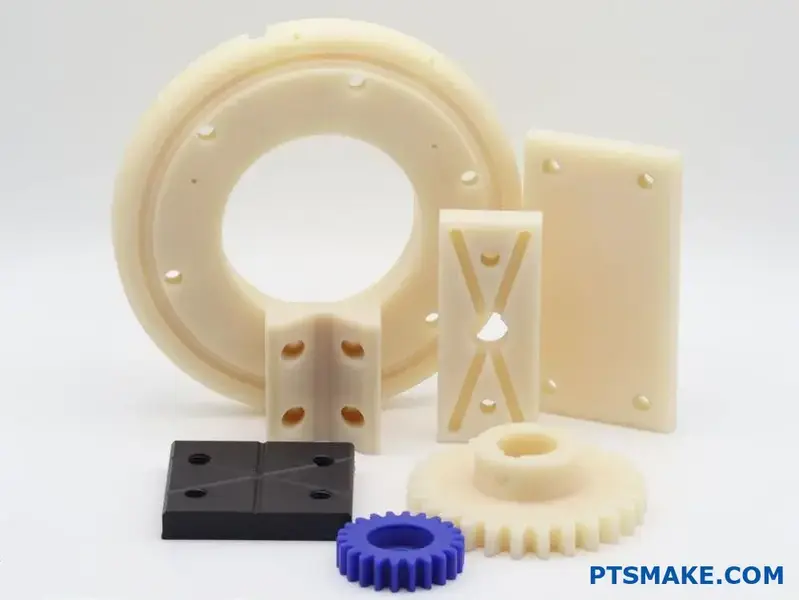
Understanding Nylon Grades for Machining Applications
When selecting the right nylon for machining processes, understanding the differences between various grades is crucial. In my experience working with clients across industries, I’ve found that making the correct material selection directly impacts both manufacturability and end-product performance.
Cast vs. Extruded Nylon: Critical Differences
Cast nylon typically offers superior machinability compared to extruded varieties. The casting process creates a more homogeneous internal structure with fewer internal stresses, resulting in better dimensional stability during and after machining. When we machine cast nylon at PTSMAKE, we generally achieve tighter tolerances and better surface finishes.
Extruded nylon, while more economical, can present challenges during machining operations. The extrusion process creates directional properties and internal stresses that may lead to anisotropic behavior4 during cutting operations. This can cause unexpected warping, especially in complex geometries or when removing significant amounts of material.
Key Nylon Types for Machining Applications
Several nylon grades stand out for machining applications:
Nylon 6/6: The Gold Standard
Nylon 6/6 remains the most widely used grade for machining applications. Its combination of strength, stiffness, and wear resistance makes it versatile for various components. The cast version of Nylon 6/6 machines particularly well, with excellent chip formation and minimal tool wear.
Nylon 6: Good Machinability with Lower Melting Point
Nylon 6 offers slightly different properties than 6/6, with a lower melting point and good impact resistance. While it machines well, its lower heat resistance can sometimes cause issues during high-speed operations when heat buildup is significant.
Modified Nylon Grades
For specialized machining applications, modified nylons offer enhanced properties:
| Nylon Type | Key Attributes | Best Applications |
|---|---|---|
| Oil-filled Nylon | Improved lubricity, reduced friction | Bearings, wear surfaces, gears |
| MoS2-filled Nylon | Enhanced wear resistance, low friction | High-wear components, sliding parts |
| Glass-filled Nylon | Higher stiffness, dimensional stability | Structural components, high-load applications |
| Heat-stabilized Nylon | Better temperature resistance | Components exposed to elevated temperatures |
Machining Considerations for Different Nylon Grades
Tool Selection and Cutting Parameters
When machining nylon, I recommend using sharp, polished cutting tools with positive rake angles. HSS and carbide tools work well, but the key is maintaining sharpness to prevent melting and dragging of the material.
Cutting parameters vary by grade:
- Standard nylon: Moderate speeds (300-800 SFM) with higher feed rates
- Glass-filled nylon: Reduced speeds (250-500 SFM) with appropriate cooling to extend tool life
- Oil-filled nylon: Can often be run at higher speeds due to self-lubricating properties
Thermal Management Challenges
Heat management is perhaps the most critical factor in successful nylon machining. Nylon’s relatively low melting point (especially Nylon 6) means heat buildup can quickly lead to dimensional issues or surface defects.
For precision components, I often recommend:
- Using coolant when possible (oil-based coolants work well)
- Programming intermittent pauses for heat dissipation in deep pocketing operations
- Taking lighter finishing passes to minimize thermal effects
- Allowing adequate cooling time between operations
Dimensional Stability Considerations
Nylon’s hygroscopic nature (tendency to absorb moisture) affects both machining outcomes and long-term dimensional stability. At PTSMAKE, we store our nylon stock in controlled environments and often recommend:
- Pre-conditioning material before precision machining
- Designing parts with appropriate tolerances that account for moisture-related expansion
- Using more stable grades (like cast Nylon 6/6) for highest-precision applications
- Considering post-machining annealing for critical dimensions
Industry-Specific Grade Recommendations
Different industries have distinct requirements for machined nylon components:
Automotive and Transportation
For automotive applications, I typically recommend:
- Glass-filled Nylon 6/6 for structural components requiring stiffness
- Oil-filled grades for bearing surfaces and friction components
- Heat-stabilized varieties for under-hood applications
Medical and Food Processing
For medical applications where FDA compliance is essential:
- Natural (unmodified) Nylon 6/6 is often preferred
- Special medical-grade nylons with appropriate certifications
- Avoiding additives that might compromise biocompatibility
Industrial Equipment and Machinery
In heavy industrial applications:
- MoS2-filled nylon for sliding components and guides
- Glass-reinforced grades for structural components under load
- Cast nylon for large, precision components where dimensional stability is crucial
By selecting the appropriate nylon grade and adapting machining strategies accordingly, manufacturers can achieve excellent results across a wide range of applications. The best grade ultimately depends on the specific requirements of your application, including mechanical properties, operating environment, and precision needs.
Should You Use Coolant When Machining Nylon?
Have you ever watched your carefully designed nylon parts warp right before your eyes during machining? Or struggled with gummy chips clogging your tools and ruining surface finishes? Many engineers face these frustrating issues when working with nylon, often wondering if coolant is the answer or the enemy.
When machining nylon, coolant should generally be avoided for most applications. Nylon’s low melting point and hygroscopic nature make dry machining preferable in most cases. However, specific high-speed or precision operations may benefit from minimal, controlled coolant application.
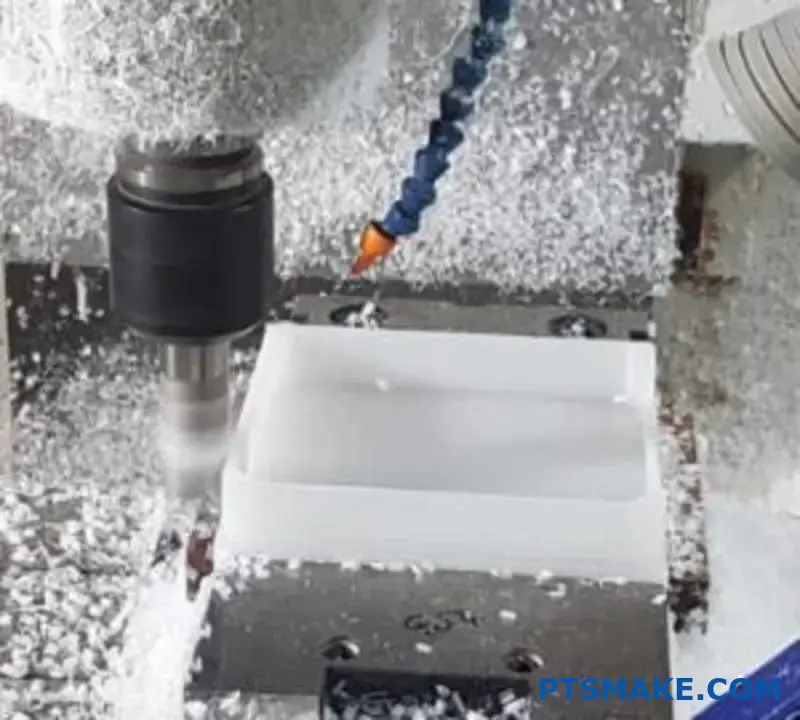
Understanding Nylon’s Thermal Sensitivity in Machining
Nylon presents unique challenges during machining primarily because of its thermal properties. With a relatively low melting point ranging from 160°C to 260°C (320°F to 500°F) depending on the specific type, nylon can quickly soften or even melt from the heat generated during cutting operations. This thermal sensitivity creates a balancing act that requires careful consideration.
In my experience working with various engineering plastics at PTSMAKE, I’ve found that nylon’s thermal conductivity5 is significantly lower than metals – typically around 0.25 W/m·K compared to aluminum’s 205 W/m·K. This poor heat dissipation means that heat generated during machining tends to concentrate at the cutting zone rather than dissipating throughout the workpiece.
Heat Generation: The Double-Edged Sword
The friction between cutting tools and nylon generates heat that can be both beneficial and problematic:
- Beneficial heat: A moderate amount of heat softens the material slightly, allowing cleaner cuts with less force
- Problematic heat: Excessive heat leads to melting, gumming, dimensional inaccuracy, and poor surface finish
This duality makes coolant decisions particularly crucial when working with nylon materials.
The Case Against Coolant for Nylon Machining
There are several compelling reasons why many experienced machinists avoid using coolant when working with nylon:
1. Moisture Absorption Concerns
Nylon is highly hygroscopic, meaning it readily absorbs moisture from its environment. When exposed to water-based coolants, nylon parts can:
- Absorb moisture during machining
- Experience dimensional changes
- Develop internal stresses
- Exhibit reduced mechanical properties
I’ve seen numerous parts that met specifications directly after machining only to be out of tolerance 24 hours later due to moisture absorption.
2. Thermal Shock Risk
The temperature differential created by applying cool liquid to a heated cutting zone can cause:
- Uneven thermal expansion/contraction
- Internal stresses in the material
- Potential cracking in thin sections
- Dimensional inaccuracies
When Coolant Might Be Beneficial
Despite the general recommendation against coolant, certain situations may warrant its controlled use:
High-Speed Machining Operations
For operations where cutting speeds exceed 500 SFM (surface feet per minute), heat buildup can become unmanageable through dry machining alone. In these cases, a minimal mist coolant system might be appropriate, using:
| Coolant Type | Advantages | Disadvantages |
|---|---|---|
| Air blast | No moisture contamination, Removes chips effectively | Limited cooling capacity |
| Oil mist | Better lubrication, Minimal moisture impact | Cleanup challenges, Environmental concerns |
| Alcohol-based coolants | Rapid evaporation, Good cooling | Flammability concerns, Cost |
Precision Operations on Large Parts
When machining large nylon components with tight tolerances, controlled coolant application might be necessary to maintain dimensional stability. In these situations, I recommend:
- Using the minimum quantity of coolant needed
- Employing compressed air to remove chips when possible
- Considering specialized cooling methods like cryogenic cooling for critical applications
Practical Coolant-Free Machining Strategies
When working with nylon at PTSMAKE, we typically implement these strategies instead of using coolant:
Optimized Cutting Parameters
| Parameter | Recommendation for Nylon |
|---|---|
| Cutting Speed | 300-500 SFM (slower than metals) |
| Feed Rate | Higher than metals (0.005-0.015 ipr) |
| Depth of Cut | Moderate to heavy (avoid light cuts that rub) |
| Tool Geometry | Sharp tools with high rake angles (15-30°) |
Effective Chip Management
Without coolant flushing chips away, proper chip evacuation becomes critical:
- Use tools with polished flutes specifically designed for plastics
- Implement frequent peck drilling cycles for deep holes
- Consider vacuum systems for chip removal in enclosed machining centers
- Schedule regular tool path interruptions to allow cooling in extended operations
Temperature Control Methods
Rather than coolant, consider these alternative cooling approaches:
- Programmed dwell times between operations
- Multiple light finishing passes instead of one heavy pass
- Compressed air cooling directed at the cutting zone
- Periodic machine pauses for natural cooling on complex parts
Making the Right Decision for Your Project
The coolant decision ultimately comes down to balancing multiple factors specific to your application. At PTSMAKE, we assess each project individually, considering:
- The nylon grade being machined (glass-filled variants have different properties)
- The complexity and tolerances of the part
- Production volume requirements
- Post-machining requirements (will parts be annealed or otherwise treated?)
For most standard nylon machining operations, our experience shows that dry machining with optimized parameters produces superior results compared to coolant-based approaches.
How to Avoid Deformation in Nylon Machining?
Have you ever spent hours meticulously designing a nylon part, only to find it warped and misshapen after machining? Or watched in frustration as your precisely measured dimensions somehow didn’t translate to the final product? Nylon’s tendency to absorb moisture and respond dramatically to temperature changes can turn what should be straightforward machining into a headache.
To avoid deformation in nylon machining, you need to control four critical factors: proper material selection, consistent temperature control, appropriate machining parameters, and strategic part design. These elements work together to minimize internal stresses that cause warping and dimensional instability.
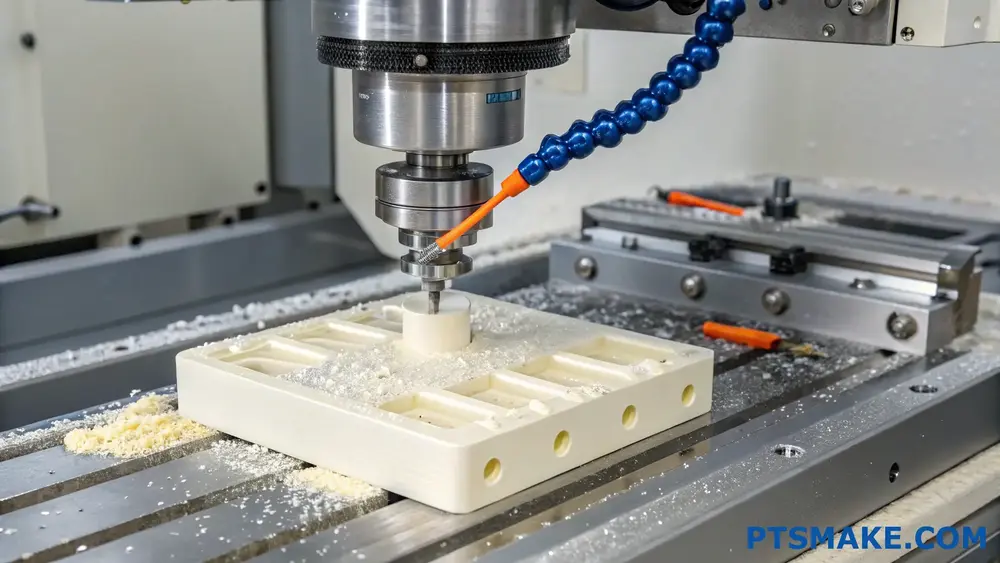
Understanding Why Nylon Parts Deform
Nylon’s inherent properties make it both valuable and challenging to machine. This versatile engineering plastic offers excellent wear resistance and mechanical properties, but these same characteristics can lead to deformation issues during machining.
Material Properties Affecting Deformation
Nylon is notorious for its hygroscopic nature6 – meaning it readily absorbs moisture from the environment. This property, while beneficial for some applications, creates significant challenges during machining. When nylon absorbs water, it can expand up to 2-3% in size, causing dimensional instability.
Additionally, nylon has a relatively high thermal expansion coefficient compared to metals. During machining operations, the friction between cutting tools and the material generates heat, causing localized expansion. As the part cools unevenly, internal stresses develop, leading to warping and distortion.
Common Types of Deformation
In my work at PTSMAKE, I’ve observed several recurring deformation patterns in nylon machining:
- Warping – The part bends or twists from its intended shape
- Shrinkage – The part dimensions decrease after machining
- Swelling – The part expands due to moisture absorption
- Stress whitening – Localized discoloration appears in areas of high stress
Pre-Machining Preparation Techniques
Proper preparation is essential to successful nylon machining. I always recommend these practices to minimize deformation risks.
Material Conditioning
Before any cutting begins, I ensure the nylon stock is properly conditioned. This involves:
- Storing nylon in climate-controlled environments (20-25°C, 40-60% relative humidity)
- Pre-drying material in specialized ovens (80-85°C for 8-12 hours)
- Allowing the material to reach thermal equilibrium with the machining environment
Stock Selection Considerations
When selecting nylon stock for machining, consider these factors:
| Nylon Type | Moisture Sensitivity | Dimensional Stability | Best Applications |
|---|---|---|---|
| Nylon 6 | High | Moderate | General purpose parts |
| Nylon 6/6 | Moderate | Good | Structural components |
| Nylon MDS | Low | Excellent | Precision components |
| Cast Nylon | Moderate | Very Good | Large mechanical parts |
For critical components requiring tight tolerances, I typically recommend pre-stabilized grades like Nylon MDS (Moisture Dimensionally Stable) which offer superior dimensional control.
Optimized Machining Parameters
The machining process itself significantly impacts nylon deformation. Careful control of cutting parameters is essential.
Cutting Speed and Feed Rate
I’ve found these cutting parameters work best for nylon machining:
- Cutting speeds: 500-1000 ft/min (lower for glass-filled varieties)
- Feed rates: 0.005-0.015 inches per revolution
- Depth of cut: Multiple light passes rather than fewer heavy ones
These parameters help minimize heat generation, which is the primary enemy of dimensional stability in nylon machining.
Tool Selection and Cooling Strategies
Tool selection dramatically affects heat generation:
- Tool material: Carbide or high-speed steel tools with polished surfaces
- Tool geometry: Sharp cutting edges with positive rake angles (15-20°)
- Coolant: Flood cooling with water-soluble fluids is preferable
At PTSMAKE, we’ve developed specialized cooling strategies for nylon machining, often using directed air cooling when liquid coolants aren’t feasible. This helps maintain consistent temperatures throughout the workpiece.
Part Design Strategies to Minimize Deformation
Even with perfect machining techniques, poorly designed parts will still deform. I always consider these design principles:
Wall Thickness and Geometry Considerations
- Maintain uniform wall thickness whenever possible
- Avoid sharp corners (use radius of at least 0.5mm)
- Design for symmetrical stress distribution
- Include ribbing or other reinforcement for thin walls
Stress Relief Techniques
For complex parts, I recommend:
- Rough machining oversized by 0.5-1mm
- Natural stress relief period (24-48 hours)
- Final machining to specified dimensions
- Final stabilization period before inspection
Post-Machining Treatments
After machining, proper handling and treatment can prevent late-stage deformation.
Heat Stabilization
Heat stabilization involves:
- Slowly heating parts to just below glass transition temperature
- Holding at temperature for 1-4 hours (depending on thickness)
- Slow cooling at controlled rate
This relieves internal stresses and "locks in" the final dimensions.
Storage and Handling Best Practices
To maintain dimensional stability after machining:
- Store in sealed containers with desiccant packets
- Maintain consistent environmental conditions
- Handle with clean gloves to prevent oil or moisture transfer
- Package in moisture-barrier materials for shipping
At PTSMAKE, we implement specialized quality control procedures for nylon parts, including dimensional verification after a stabilization period to ensure long-term stability.
What Are the Key Tool Selection Tips for Nylon Machining?
Have you ever started machining nylon only to watch your parts melt before your eyes? Or struggled with tools that constantly clog with material, forcing you to halt production repeatedly? The frustration of selecting the wrong tools for nylon machining can turn straightforward projects into costly nightmares.
Selecting the right tools for nylon machining requires consideration of specific cutting geometries, coating types, and tool materials. Optimal tools include carbide end mills with polished flutes, sharp cutting edges with positive rake angles, and adequate chip clearance to prevent melting and ensure dimensional accuracy.

Understanding Tool Geometry for Nylon
When machining nylon, the right tool geometry makes all the difference between perfect parts and scrapped material. I’ve found that tools with positive rake angles typically perform best because they cut through the material cleanly rather than pushing against it, which can cause deformation.
High Helix Angles for Better Chip Evacuation
For nylon materials, high helix angle tools (35-45 degrees) provide superior chip evacuation. This is crucial because nylon’s low melting point makes heat management a priority. Better chip evacuation means less heat buildup and fewer instances of the dreaded "material welding" to your cutting tool.
I recommend using two-flute end mills for most nylon applications. More flutes might improve surface finish, but they reduce chip space and increase heat – something nylon simply can’t tolerate.
Polished Flutes Prevent Material Adhesion
One often overlooked aspect of tool selection is surface finish. Tools with polished flutes significantly reduce the friction between the tool and nylon chips, preventing the galling phenomenon7 that occurs when nylon starts to melt and stick to the tool.
At PTSMAKE, we’ve standardized on polished tools for our nylon machining operations, which has dramatically improved our tool life and part quality, especially for precision components used in medical and automotive applications.
Material Considerations for Cutting Tools
The choice of tool material significantly impacts machining performance with nylon.
Carbide vs. HSS Tools
While high-speed steel (HSS) tools are more affordable, carbide tools offer several advantages for nylon machining:
| Tool Material | Advantages | Disadvantages | Best Applications |
|---|---|---|---|
| Carbide | Longer tool life, Better heat resistance, Maintains sharper edge | Higher initial cost, More brittle | Production runs, Precision parts |
| HSS | Lower cost, Less brittle, Easily resharpened | Shorter tool life, Loses edge faster | Prototyping, Low-volume jobs |
For most nylon machining applications, I recommend carbide tools despite their higher initial cost. Their ability to maintain a sharp cutting edge and resist heat buildup yields better part quality and lower overall costs when factoring in reduced downtime and scrap rates.
Tool Coatings for Nylon Applications
Specialized coatings can further enhance tool performance:
- Diamond-Like Carbon (DLC) coatings reduce friction and heat buildup
- TiN (Titanium Nitride) provides good wear resistance while maintaining sharp edges
- Uncoated polished tools sometimes outperform coated options for nylon specifically
I’ve found that while coatings offer benefits, a well-polished uncoated carbide tool often provides the best results for nylon. The low cutting forces required for nylon mean edge wear is less of an issue than heat management and chip evacuation.
Specific Tool Recommendations by Operation
Different machining operations require specific tool configurations for optimal results with nylon.
End Mills for Profiling and Pocketing
For general profiling and pocketing operations in nylon:
- Two-flute carbide end mills with high helix angles (40°+)
- Polished flutes to prevent material adhesion
- Sharp cutting edges with 10-15° rake angles
- Adequate chip space for material evacuation
Drills for Hole-Making
When drilling nylon:
- Use drills with polished flutes
- Select point angles between 90-118° (less aggressive than for metals)
- Consider using peck drilling cycles for deeper holes
- Drill sizes 0.1-0.2mm larger than final hole dimension to account for material rebound
Special Considerations for Glass-Filled Nylon
Glass-filled nylon presents additional challenges due to its abrasive nature:
- Tool Material: Solid carbide is essential, as HSS tools wear extremely quickly
- Edge Geometry: Slightly duller edges (honed) resist chipping better than razor-sharp edges
- Coating: Diamond or diamond-like coatings significantly extend tool life
- Reduced Speeds: Run 15-25% slower than with unfilled nylon
I’ve experienced dramatically improved tool life when using diamond-coated tools on glass-filled nylon components at PTSMAKE. While they cost more initially, the extended life and reduced downtime provide significant ROI, especially for production runs.
Optimizing Tool Selection for Different Nylon Grades
Different nylon grades have unique machining characteristics that influence tool selection:
Nylon 6 vs. Nylon 6/6
Nylon 6/6 is generally more rigid and heat-resistant than Nylon 6, allowing for slightly more aggressive cutting parameters. For Nylon 6, I recommend:
- More conservative speeds
- Higher rake angle tools
- Enhanced cooling methods
Cast vs. Extruded Nylon
Cast nylon typically machines better than extruded grades due to its more consistent internal structure. For extruded nylon, consider:
- Using sharper tools with higher rake angles
- Lower feed rates to reduce cutting forces
- More aggressive cooling strategies
By understanding these nuances between nylon grades, you can make smarter tool selections that produce better results while extending tool life.
Tool Selection Strategy for Complex Nylon Parts
When machining complex nylon components with multiple features, a strategic approach to tool selection can significantly improve efficiency:
- Minimize tool changes by selecting versatile tools that can perform multiple operations
- Consider roughing/finishing tool pairs specifically designed for nylon
- Use the largest diameter tools possible for better heat dissipation
- Balance surface finish requirements with production efficiency
At PTSMAKE, our approach to complex nylon parts involves careful planning of tool sequences, often using specialized combination tools that reduce cycle times while maintaining the precise tolerances our aerospace and medical clients require.
How Does Moisture Affect Nylon Machining Results?
Ever struggled with nylon parts that suddenly warp or change dimensions after machining? Have you spent hours perfecting tolerances only to find your parts don’t fit as designed days later? This frustrating phenomenon might not be your machining process—it could be moisture at work.
Moisture significantly affects nylon machining results by causing dimensional instability, warping, and performance changes. Nylon absorbs water from the environment (up to 8-10% by weight), which alters its size, mechanical properties, and machinability. Proper moisture management is essential for achieving consistent, high-quality machined nylon components.

Understanding Nylon’s Hygroscopic Nature
Nylon is classified as a hygroscopic material, meaning it readily absorbs moisture from its surroundings. This characteristic sets it apart from many other engineering plastics and creates unique challenges during machining processes. In my experience working with precision components at PTSMAKE, I’ve found that nylon can absorb anywhere from 1.5% to 10% moisture by weight, depending on the specific type.
The absorption mechanism occurs at the molecular level, where water molecules form hydrogen bonds with the amide groups in nylon’s polymer chains. This interaction causes the polymer chains to move further apart, resulting in swelling of the material. What makes this particularly challenging is that the absorption isn’t merely a surface phenomenon—it occurs throughout the entire material, though at different rates.
Moisture Absorption Rates by Nylon Type
Different nylon variants show varying degrees of moisture sensitivity:
| Nylon Type | Maximum Moisture Absorption | Time to Reach Equilibrium |
|---|---|---|
| Nylon 6 | 9-10% | 2-3 days |
| Nylon 6/6 | 8-8.5% | 3-4 days |
| Nylon 11 | 1.9-2.0% | 5-7 days |
| Nylon 12 | 1.5-1.8% | 6-8 days |
The Dimensional Impact of Moisture on Machined Parts
When moisture enters nylon, it doesn’t just stay there passively—it fundamentally changes the material’s dimensions. This presents serious challenges for precision machining. A part machined to exact specifications might change size as it absorbs or releases moisture, potentially rendering it unusable for its intended application.
In typical indoor environments (50% relative humidity), nylon can expand by 0.2-0.3% in all dimensions. While this might seem insignificant, for precision components with tight tolerances of ±0.001 inches (0.0254 mm), such expansion can cause parts to fall out of specification. The expansion isn’t always uniform either, which can lead to warpage and distortion in complex geometries.
Changes in Mechanical Properties
Beyond dimensional changes, moisture affects nylon’s mechanical performance in ways that directly impact machining:
- Decreased Stiffness: Water acts as a plasticizer8 in nylon, reducing its modulus of elasticity by up to 30% at saturation
- Lower Tensile Strength: Moisture can reduce tensile strength by 15-25%
- Increased Flexibility: Wet nylon displays greater elongation before breaking
- Heat Resistance Changes: The heat deflection temperature drops significantly
Machining Challenges with Moisture-Laden Nylon
Cutting wet nylon creates specific machining challenges that differ from working with dry material. When moisture content is high, I’ve observed several common issues:
Tool Wear and Cutting Performance
Moisture-laden nylon tends to be softer and more gummy, which can lead to:
- Built-up Edge Formation: Material adheres to cutting edges, affecting surface finish
- Poor Chip Evacuation: Wetter material creates stringier chips that can wrap around tooling
- Inconsistent Cutting Forces: As the material’s properties change with moisture content, cutting forces become less predictable
- Heat Management Issues: Moisture affects the thermal conductivity of the material
Finishing and Surface Quality Problems
The surface finish of machined nylon parts is particularly sensitive to moisture content:
- Smearing: Wet nylon tends to smear rather than cut cleanly
- Poor Dimensional Stability: Parts may change dimensions as they equilibrate with ambient conditions
- Surface Roughness Variations: Moisture content affects achievable surface finish quality
- Post-machining Shrinkage: As parts dry out, they may shrink unevenly
Moisture Management Strategies for Optimal Results
Based on my work with clients across medical, automotive, and aerospace industries, I’ve developed several practical approaches to managing moisture in nylon machining:
Pre-Machining Conditioning
- Controlled Drying: For critical components, drying nylon at 80°C (175°F) for 12-24 hours before machining creates a known moisture baseline
- Environmental Control: Maintaining consistent shop humidity levels (ideally 40-50% RH) reduces unpredictable moisture fluctuations
- Material Storage: Storing nylon stock in sealed containers with desiccants prevents moisture absorption before machining
Machining Parameter Adjustments
Adjusting machining parameters based on the material’s moisture content improves results:
- Cutting Speed Reduction: Reducing speeds by 10-15% for wet nylon helps prevent gumming and heat buildup
- Tool Geometry Selection: Sharper cutting edges and higher rake angles improve cutting action in moisture-laden material
- Cooling Strategy: Dry cutting or minimal lubrication often works better than flood coolant
Practical Applications and Success Stories
At PTSMAKE, we recently helped a medical device manufacturer resolve erratic fit issues in a nylon component assembly. By implementing a controlled pre-machining drying protocol and adjusting the machining parameters, we achieved consistent part dimensions with ±0.0005" tolerance—even after the parts had been in service for several months.
For another aerospace client, we developed a custom environmental stabilization process that involved machining parts slightly oversized, then allowing them to equilibrate in a controlled environment before final precision machining. This approach compensated for the inevitable moisture-related dimensional changes and delivered components that maintained their critical dimensions throughout their service life.
Can Nylon Machining Achieve Aerospace-Grade Precision?
Have you ever wondered if your nylon components could meet the exacting standards of aerospace applications? The gap between typical nylon machining and aerospace requirements often seems insurmountable, leaving engineers frustrated with parts that fall short of critical specifications when lives and missions are at stake.
Yes, nylon machining can achieve aerospace-grade precision through advanced CNC technologies, specialized tooling, and strict quality control protocols. Modern precision manufacturing techniques enable nylon parts to meet tolerances as tight as ±0.001 inches, satisfying stringent aerospace requirements.
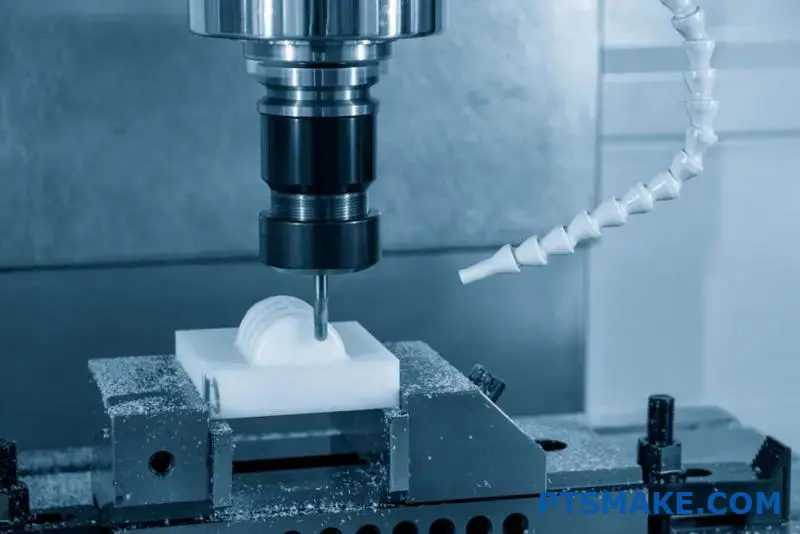
The Intersection of Nylon Properties and Aerospace Requirements
Nylon has become increasingly popular in aerospace applications due to its unique combination of properties. When properly machined, this versatile polymer offers exceptional strength-to-weight ratios, self-lubricating properties, and resistance to wear and vibration – all critical factors in aerospace environments.
The challenge lies in bridging the gap between nylon’s natural properties and aerospace’s demanding specifications. Through my work at PTSMAKE, I’ve found that understanding this intersection is crucial for successful precision machining.
Critical Aerospace Tolerances for Nylon Components
Aerospace tolerances typically require precision within ±0.001 to ±0.0005 inches. For nylon components, achieving these tolerances requires special consideration of the material’s thermal expansion coefficient9 – approximately 3-4 times higher than aluminum. This means temperature control during machining is non-negotiable.
Consider these typical aerospace tolerance requirements for various applications:
| Application | Typical Tolerance | Surface Finish | Special Requirements |
|---|---|---|---|
| Bushings/Bearings | ±0.0005" | 16-32 μin | Concentricity within 0.001" |
| Spacers | ±0.001" | 32-63 μin | Flatness within 0.0005" |
| Gears | ±0.0007" | 16-32 μin | Tooth profile accuracy ±0.0003" |
| Structural Components | ±0.002" | 32-63 μin | Perpendicularity within 0.001" |
Advanced Machining Techniques for Aerospace-Grade Nylon
Achieving aerospace precision with nylon requires specialized approaches that account for the material’s unique characteristics.
Temperature-Controlled Machining Environment
One of the most critical factors in precision nylon machining is temperature control. We maintain our CNC machining centers at consistent temperatures (typically 68-72°F) to prevent dimensional changes during cutting operations. This consistency is essential for meeting aerospace tolerances.
Temperature fluctuations as small as 5°F can cause dimensional changes of up to 0.002" in larger nylon components – enough to fail aerospace inspections. By controlling ambient and cutting temperatures, we consistently achieve tolerances of ±0.001" or better.
Specialized Tooling and Cutting Parameters
Conventional cutting tools designed for metals often cause excessive heat buildup and poor surface finishes when used on nylon. We utilize specialized tooling with:
- Sharp, polished cutting edges
- Higher relief angles (15-20° compared to 7-10° for metals)
- Diamond or specialized coatings for reduced friction
Cutting parameters must also be adapted for aerospace-grade precision:
- Higher cutting speeds (300-500 SFM)
- Moderate feed rates to prevent melting
- Light finishing passes (often 0.005" or less)
- Compressed air cooling rather than liquid coolants that may cause dimensional instability
Quality Assurance for Aerospace Nylon Components
Meeting aerospace standards requires more than just precise machining – it demands comprehensive quality assurance protocols.
Metrology in Climate-Controlled Environments
All critical measurements for aerospace nylon components should be performed in climate-controlled metrology labs. At PTSMAKE, we maintain our inspection environment at 68°F (20°C) with humidity control to prevent measurement variations due to material expansion.
For the most critical dimensions, we implement a 24-hour stabilization period before final inspection, allowing the nylon to fully acclimate to the inspection environment. This step alone has improved our first-pass inspection rates by over 30% on aerospace components.
Specialized Aerospace Certifications
To truly achieve aerospace-grade precision, manufacturers must adhere to specific industry certifications:
- AS9100D certification (aerospace-specific quality management)
- NADCAP approval for special processes
- Material traceability documentation
- First article inspection reports (FAIRs)
These certifications ensure not just precision in individual components, but consistency across production batches – essential for aerospace applications where component interchangeability is critical.
Case Study: Nylon Bearing Components for Aircraft Control Systems
Recently at PTSMAKE, we manufactured nylon bearing components for aircraft control systems with tolerances of ±0.0005" on critical dimensions. These components had to maintain precision under varying temperature and humidity conditions while offering self-lubricating properties.
By implementing specialized fixtures, a climate-controlled environment, and advanced CNC programming techniques, we achieved 99.8% first-pass yield on these components. The keys to success included:
- Custom workholding to minimize distortion
- Five-axis machining for single-setup precision
- In-process laser measurement
- Statistical process control to maintain consistency
This project demonstrated that with the right approach, nylon machining can indeed achieve and maintain aerospace-grade precision, even for flight-critical components.
Understanding this property helps prevent machining errors and material waste. ↩
Learn about fiber orientation effects in reinforced nylons and best practices. ↩
Learn why proper heat management is essential for preventing nylon part deformation during machining. ↩
Material properties varying with direction – critical in machining considerations. ↩
Learn how thermal properties affect material selection for optimal machining results. ↩
Learn about moisture absorption effects on nylon machining precision. ↩
Learn about this adhesive wear mechanism and how to prevent it in nylon machining. ↩
A substance that increases plasticity or fluidity when added to materials. ↩
Learn how thermal expansion affects precision in aerospace nylon parts. ↩



